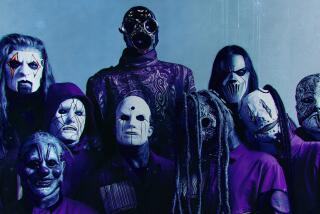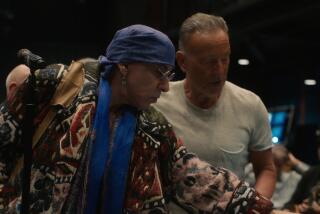U2 Looking Ahead but Keeping the Future Open
“This is just the end of something for U2,” Bono announced at the final stop on the group’s 1989 tour in Dublin. “It’s no big deal, it’s just that we have to go away and dream it all up again.”
As it turned out, going away did prove to be a big deal. When U2 resurfaced in late 1991, the quartet had a new sound and a new approach to live shows.
The new “dream”--as unveiled in the “Achtung Baby” album that year--was more questioning, introspective themes and harsher, high-tech musical textures than in such earlier albums as “The Joshua Tree,” which was chosen the fourth-best album ever in a recent vote by more than 1,500 readers of The Times. The “Zoo TV” stage show also traded in U2’s former everyman intimacy in favor of lavish theatricality.
The question surrounding the band nearly a decade later is whether it is again at the end of a chapter.
The timing might be right. Though well received by critics, U2’s 1997 “Pop” album was not the expected bestseller, and the accompanying “PopMart” tour lacked the imagination and energy of “Zoo TV.”
But we probably won’t know until its new album (which reunites the group with producers Brian Eno and Daniel Lanois) is released, which probably won’t be before next fall. U2 guitarist the Edge says even the band doesn’t know.
“The exciting thing for us is we don’t know just what is ahead,” he said on the eve of this week’s release of “U2: The Best of 1980-1990,” a set with one CD devoted to hits and another to B-sides. (A single-disc version, featuring just the hits, will be released Tuesday.).
The Edge (real name Dave Evans) stressed in an interview that the group is purposely keeping its options open, though it does appear that it is through with stadium tours for a while.
*
Question: Is there any parallel between now and the end of the “Rattle and Hum” tour?
*
Answer: I think “Rattle and Hum” sort of completed the circle for me in a weird way. Having started off as a young band in the post-punk late ‘70s, we really weren’t that interested in the blues or American roots music. We were interested in a lot of innovative, avant-garde music, and that continued right through “The Joshua Tree,” which is when we quite consciously decided to take a look at America, both lyrically and musically. That was the overriding theme of “Rattle and Hum.”
After “Rattle and Hum,” it did feel like that was a break of some kind . . . that we were about to start a new direction. . . . Right now, it’s hard for me to say we are at the beginning of something or at the end. We are waiting for the music to tell us just where we are going.
Q: Do you think of the U2 of the ‘80s as a fundamentally different band from the U2 of the ‘90s?
A: No, we weren’t different bands in those decades. It’s just that we are in a constant state of development and evolution, and that’s one thing I’ve enjoyed about the band.
Q: Do you have a target release date for the new album?
A: We are aiming to finish it sometime in the summer, but we don’t want to set a firm deadline because we don’t want to get into the same trap that we did last time. We made a mistake of establishing a deadline too far in advance with “Pop.” The last month turned out to be a real scramble to get it out before the “PopMart” tour.
Q: Do you think the album suffered?
A: I don’t think the album suffered so much, though we might have wanted another week to just sit back and relax with it . . . .so that we wouldn’t have had to deliver it to the record company the day it was finished, which is what we ended up doing. I might have preferred another mix on one or two of the singles.
Q: Is there any way you can describe the sound of the material you are working on now?
A: I’m [nervous] about that--after what happened with “Pop” . . . the way people started making judgments even before they ever heard it. There were stories about it being a dance record or an electronica record because Bono said there might be a bit of a dance influence on it and because we brought in [dance producer] Howie B to work with us. It’s incredible how much that rumor [shaped] people’s opinion of the record. The truth is that it wasn’t a dance record. It was a band record. We used a few loops like we would an extra percussion player, but [drummer] Larry [Mullen] played everything on that record.
Q: What about the next tour? Stadiums or arenas?
A: The mood at the moment would be to do something small, having done “Zoo TV” and “PopMart,” it’s like we’ve done that. The idea in those tours was to look at a stadium show as a concept. We wanted to see if you could do a show so that it just wasn’t a lot of people seeing matchstick men jumping around on stage 200 yards away with some bad sound and feeling in the end like you had been at some weird tribal gathering rather than anything to do with music. . . . I’m very proud of both tours. I felt we managed to do something that made legitimate the whole idea of playing in stadiums.
Q: So why not do it again?
A: The truth is it takes such an incredible amount of energy and time and money to do stadiums. It’s not that we want an easy life, but having done it twice now, we are going to wait awhile before we think about it before making another commitment.
Q: How do you feel about pop music these days? Do you hear much that excites you?
A: I can’t say there is a lot, but there are bits and pieces. I like some hip-hop. I got the new Public Enemy album [the “He Got Game” soundtrack] and I love Wyclef Jean’s “Gone ‘Til November” single. The Lauryn Hill record is really good. In rock, I enjoyed the Verve album, but it’s the Bob Dylan album [“Time Out of Mind”] that was really fantastic. He’s so inspiring. It shows how you you can still come up with great work. That’s always the challenge. . . .
More to Read
The biggest entertainment stories
Get our big stories about Hollywood, film, television, music, arts, culture and more right in your inbox as soon as they publish.
You may occasionally receive promotional content from the Los Angeles Times.










